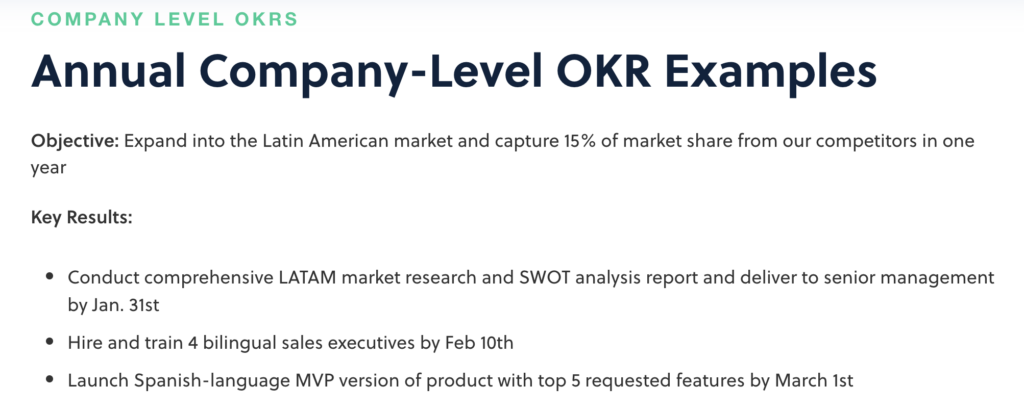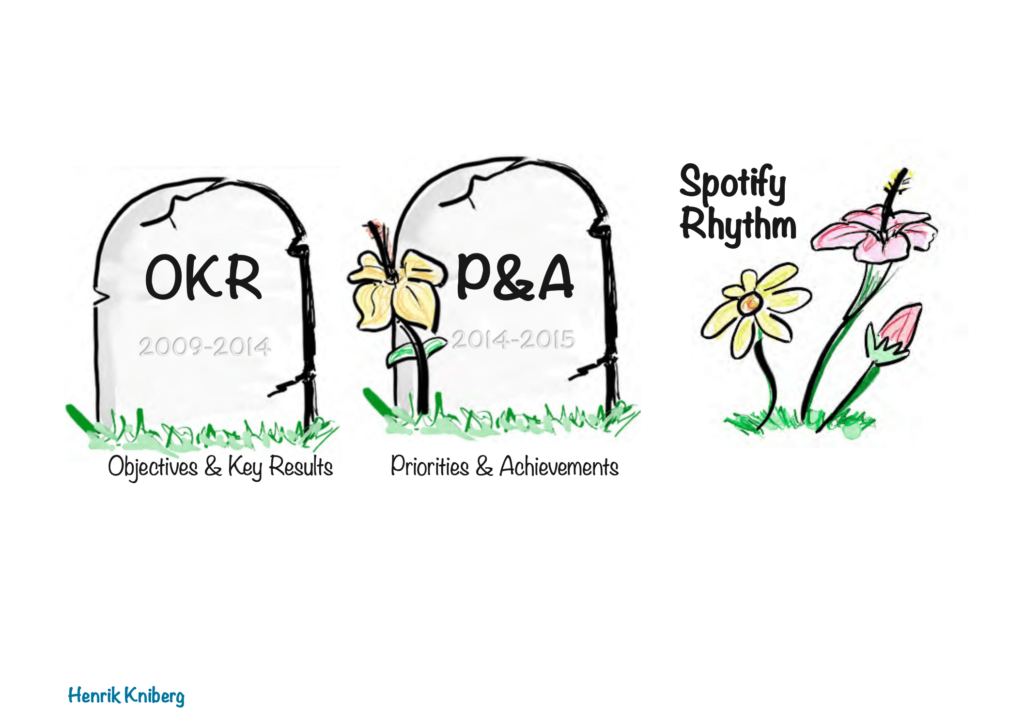OKR (objectives and key results) is a popular management framework aimed to create alignment and focus. But it’s not the silver bullet in leading an effective organization where top-down alignment and bottoms up innovation are both essential. How do you assess whether your OKR process is ruining innovation? And how will you implement OKRs that empower your teams? Here’s something to keep in mind when setting product OKRs.
When an OKR Process is Ruining Innovation
Bespoke Cascading OKRs
A common way to implement OKRs is starting from the top and breaking big goals into smaller pieces for each level of the organization to focus on. This is called cascading OKRs.
In theory, this makes sense, but many companies implemented it poorly by having a list of to-dos too soon, creating a top-down command and control management (or micro-management) style, leaving little room for teams to innovate. Here is an example of a poorly implemented OKR (and sadly it’s taken from an OKR tool website)

As you may see, the strategic goal (at the company level) turns into a to-do immediately, leaving no space for the team to define how they may achieve this goal. Moreover, achieving these 3 key results will by no means indicate the success of the objective.
Top down OKR setting with to-do like key results early on will kill your product innovation by progressively shrinking the scope of aspirations.
Aligning OKRs with Org Structure
Often OKRs are designed to align with organizational structure – start with the CEO’s goals, followed by department goals, teams goals, and individual goals. The objective is measured by its key results, and subsequently, these key results become the objectives for the next level, and so forth, aligning goals with organizational structure.
Let’s take a look at an example below:

Each team gets its objective from the level above and plans out initiatives/ projects to achieve these objectives.
Take a look at project 3 – the individual member perfectly aligns with the objective. Great, but what about projects 1 and 2? They both need the support of the blue team member, but project 2 does not align with the blue team members’ objectives. Should project 2 be de-prioritized in favor of project 1?
When OKRs are implemented at a high level of precision, collaboration is discouraged. It can create silos to favor the local key results.
Take another look at the top-level – notice there is a “Big Idea” in red?
It is tied to a higher-level objective, and not immediately mapped to anyone’s focus. If no one is given the incentive to come up with bigger ideas that can map to a higher level of key results, they will not be conceived by teams with a limited scope of predefined objectives.
When teams can only align their work with team goals, it can kill your product innovation by progressively shrinking the scope of aspirations.
The Need to Evolve Process as a Company and Its Environment Evolve
How a company works between its executives and teams and between different functions and different teams, should evolve as the company evolves or the environment it operates in changes. If you Google “companies that adopted OKRs”, you can see many successful companies on the roster, including Spotify. However, their framework has been evolving at Spotify over the years. Below is a slide from Henrik Kniberg, the person responsible for leading the scaled agile process (post-Tribes, post-OKR) at Spotify.

The companies that made OKR mainstream, such as Intel and Google, can attribute their dominance largely to their economies of scale. Does this competitive differentiator work for your company, at this time?
A similar observation is agile. The “by-the-book” agile implementation has shown its own challenges outlined very well in the article aptly titled “Agile is ruining your product” by Mat Levey.
How to Implement Your OKR Process to Empower Teams?
While OKRs alone will not enable your company to best achieve customer and business outcomes, it can be part of the overall solution for an effective organization.
As product teams are key drivers to OKR success, you may find connecting OKRs with Product Initiatives an effective way to empower teams.
An effective organization enables top-down alignment, bottom-up innovation, and cross-team collaboration. It adjusts strategic focus across a variety of objectives depending on the needs of the market and state of the business. Tightly align on overall goals and strategies, enable collaboration, respond to changes across all fronts, and always keep customers your main focus. This is what we call a responsive organization – one which connects objectives, initiatives, people, and execution responsively.




